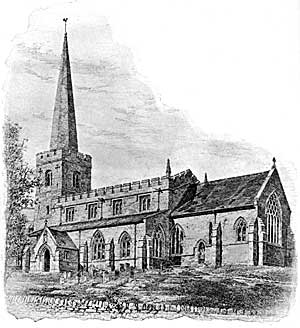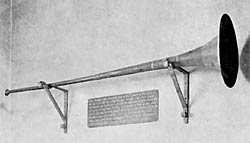East Leake

St Mary the Virgin, East Leake in 1903.
On reaching East Leake the members and their friends were kindly met by the rector, the Rev. S. P. Potter, who read the following paper in the schoolroom:
East Leake and its Church of St. Mary the Virgin.
The name of our village is the key to its history. It is a Saxon name derived from the abundance of its water. From this alone we might conclude that Leake, East or West, or even East and West, dated back to Saxon times.
Doomsday Book proves that conclusion to be correct so far as one of the villages is concerned. At that time Lecche was a village of considerable size, having a priest and church. Adjacent to it was Berew' Lecche situate in Plumtre Hundred. This Berewick or Buruh enables us to identify the village named in Doomsday Book with East Leake, for the word Borough has been linked to the east portion of East Leake in the Borough Pool still remembered by the oldest inhabitants. Hard by the site of this pool an earthwork, or as the Saxons would call it, a burh (or buruh) can be seen, suggesting that the less obvious meaning of Berew' is the right one.
We know that there was a church here before 1086. Can we say that any portion of that church remains ? The north wall may be considered to contain some of that building, but here opinions will widely differ.
I understand that pre-Reformation wills give the present dedication to St. Mary; but there is an early 14th century reference to St. Leonard's Church, which suggests that there was re-dedication to St. Mary at a period subsequent to that century.
I am asked to indicate points of interest rather than attempt to describe the church. In carrying out your wish I will ask you to perambulate the exterior, commencing with the north-east portion of the north wall of the nave. Here you will observe the herring-bone work in rubble building, possibly part of the original Saxon church. The restored north window replaces one that had been there corresponding to the original window further west. In the days of three-decker pulpits the window was knocked out and made into a round headed glazed hole to afford light.
The north doorway has suffered to oblige a local carpenter, who fitted a modern door to a vestry which now is more appropriately the detached coal-house in the churchyard.
The tower, with exception of the south door, is early English, and the spire is a good specimen of perpendicular work. This doorway was probably built early in the 18th century out of material from the old Hall. The repainted dial with its motto "Now is Yesterday's To-morrow" is mentioned in Mrs. Gatty's Book of Sundials.
The square window west of the porch is a curious unexplained feature. Its date is variously given. The porch, erected A.D. 1894, replaces one absolutely without interest, having been restored (?) with red brick. The south doorway is early English. Before restoration there were evidences that this doorway had previously been rebuilt.
On the east side of the porch, intersecting the roof there is a division in the aisle wall which leads to the theory that at some time this was the west limit of the aisle. There are features of the interior which make it difficult to accept this theory. The aisle may have been widened in two sections. About five feet from the ground on two of the buttresses of the aisle, circles with deeply pierced centres may be observed. These await explanation. The suggestion most obvious is that they were sundials.
The exterior of the east window of the aisle arrests attention by its symbolic carving. The expert who can interpret this will do us a service.
The single lancet windows in the south wall of the chancel, one restored the other unrestored, were discovered at the restoration A.D. 1886, built into the wall of the chancel.

The font, East Leake.
On entering the church the early English octagonal font is noticeable. On it the hinges of the cover are traceable, and above it is seen the pulley for raising the cover.
Above the tower arch built into the wall but visible from the bell chamber, is a round headed doorway. What was its purpose ? It is not unlikely that it was the entrance to a priest's chamber.
Beneath, traces are visible of a west gallery, which stood until the middle of last century.
The interest of the north wall has been alluded to.
There are traces of nailhead and other early English ornament on the capitals of the chancel arch, and those of the southern bay.
The careful observer will see on the easternmost arch of the arcade a trace of the rood screen ; and on the capital of the pillar beneath can be seen the place where the parclose screen was fixed. In the south wall of the aisle the hole remains in which the respond of this screen was fixed.
There are two decorated piscinas. That in the chancel has been restored, a portion of the bowl having been discovered when the chancel was rebuilt.

The Shawm, East Leake church.
In addition to interesting points in the building, we boast of a remarkable trumpet, locally called The Shawm. It is one of four existing ones, the others being at Willoughby, Harrington and Braybrooke. It measures 71/2-ft. in length and 1-ft. 9-in. across the bell mouth ; and is made of wrought iron. It was used in the church services less than 60 years ago, the bass parts being vamped through it.
There is a chained book, "The Dippers Dipt," of the date A.D. 1645. It is a relic of the early Anabaptist controversy.
In our register under the year 1644, is the entry of the burial of four soldiers, killed in the parish in a skirmish, on September the 17th between the Royalist and Parliamentarian forces. On September the 19th another soldier, who died of wounds received in the same skirmish, was buried. Tradition names the protruding slab near the porch as the gravestone of these soldiers.
The appointment of a Parish Registrar is chronicled under date A.D. 1654.
I will close my inventory with the mention of the ancient clock now in the belfry. We are hoping that you will be able to date this rusty relic.
The following additional notes on the church at East Leake will be of interest to our members. The building is of stone, mostly rubble, and is chiefly of the Early English and Decorated periods. It comprises a chancel (re-built in 1866), a clerestoried nave of four bays, a south aisle and porch, and an embattled western tower (in three stages) capped with a plain octagonal spire. One of the most interesting portions of the church is the north wall. The "herring-bone" work, to be seen from the outside, and the small, narrow windows with their deep internal splays, may be of the Norman, or even Anglo-Saxon period. The distinct evidence of a smaller and earlier church than the present one was forthcoming in 1866, when the foundations of an eastern chancel wall were discovered about fourteen feet beyond the present chancel arch. The present north wall of the nave probably belonged to this earlier church.
In the chancel are two old oak benches with "poppy heads," and at the west end, three oak benches with carved ends, and bearing the date 1612.
Externally, on the two south buttresses of the south wall, are to be seen two examples of inscribed dials, similar to those at Bunny.
In his "Companion to the Principles of Gothic Ecclesiastical Architecture," Mr. Bloxom makes mention of "paintings on canvass of Time with a scythe and hour-glass, and of Death as a skeleton with a dart in his hand." He regarded them as eighteenth century work, and gives examples of sixteenth century work of the same kind, found in Nuneaton Church, Warwickshire. The East Leake canvasses have apparently disappeared.
The church bells, which were rehung in 1902 (the second bell being also recast), have a long history. An official inventory, made 4th September, 1552, speaks of "iii belles. And that Richard Wild Thomas Asten and Thomas North are bound by recog : in xx to answer for a sacring bel sold for 5s."
The original sacring bell does not seem to have been forthcoming, unless we are wrong in regarding the present "Ting-Tang" as an unworthy successor; for there was a restoration of the three bells only, together with a chalice and paten, to the Curate in the following year. A list of other valuables, not handed over by the Commissioners will be found on page 148 of Mr. J. T. Godfrey's Nottingham Churches, and will sufficiently indicate the result in this parish of "The Great Pillage" of Edward VI.'s reign.
Early in the I7th century the first and third bells were sent to the foundry of Henry Oldfield to be re-cast; and they bear his trade mark, with inscriptions respectively of "+ GOD SAVE THE CHVRCH," and "IHESVS BE OVRE SPEDE." The second bell, prior to its recent recasting, bore the date 1627, and was without a founder's mark. It bore the same inscription as the first bell; an inscription of frequent use at that time and indicative of the troubles that were coming. The third bell was, of course, the passing bell, as its legend indicates.
